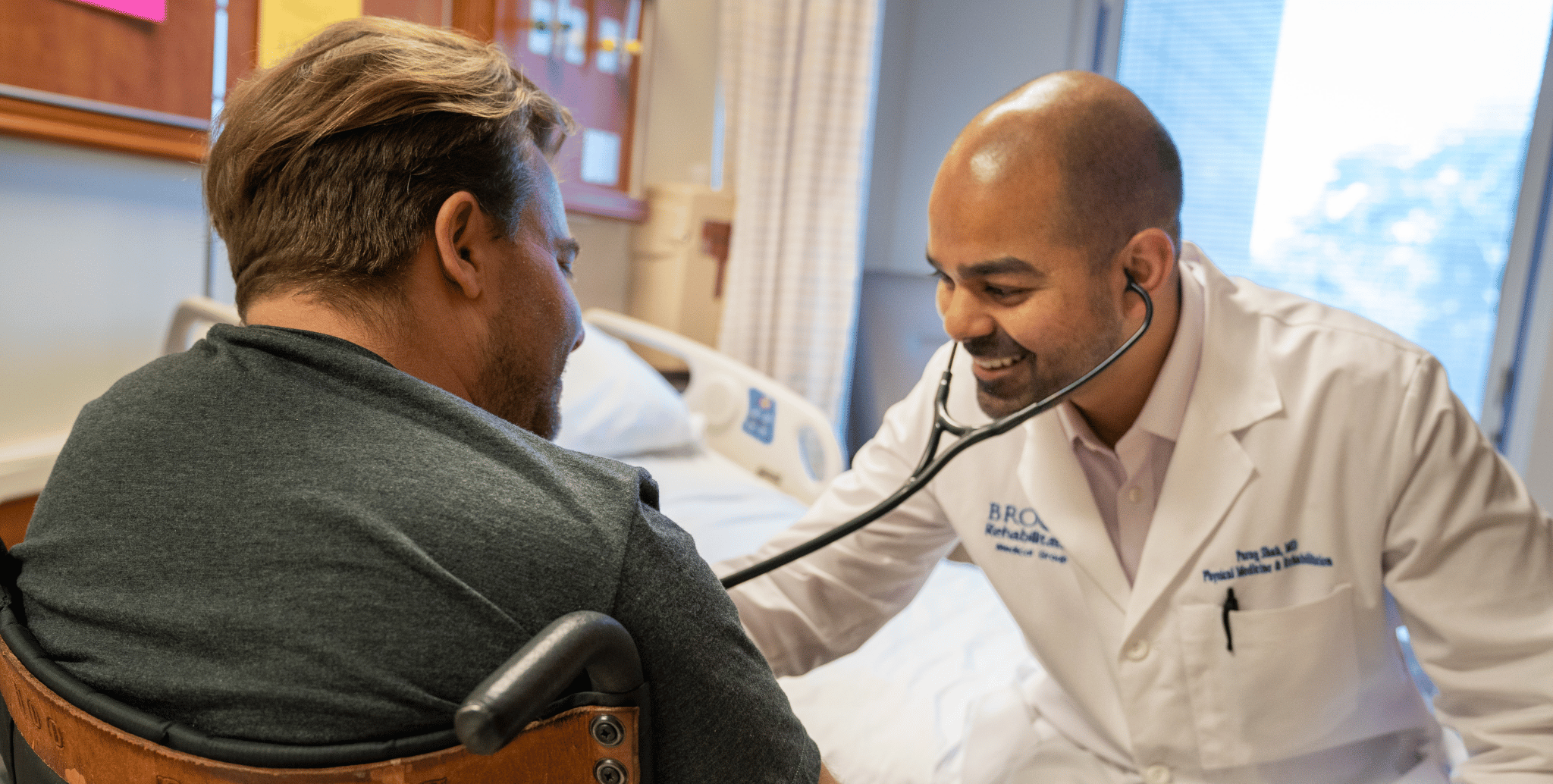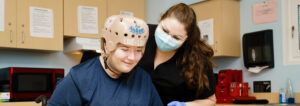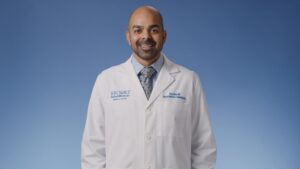Left-side Stroke: What is Damaged, Effects and Treatment

Back to physical health resource hub
What is damaged after a left-side stroke is a highly searched question. According to multiple studies, most strokes take place in the brain’s left hemisphere.
A stroke is often a life-altering medical event that can occur in young, middle-aged or elder adults. Understanding what could be damaged, the effects and treatment options available can help you or your loved one prepare for the recovery road ahead.
This article will discuss what the effects of left-side stroke are, its impact on a person’s life and treatment.
In this article, we will discuss:
-
What is a stroke
-
The types of strokes
-
Parts of the brain and what they do
-
What the left-side of the brain controls
-
What is damaged from a left-side stroke
-
The effects a left hemisphere stroke may have
-
Stroke treatment
-
Where treatment takes place
-
Patient recovery stories
What is a stroke?
A stroke occurs when the blood flow to the brain is interrupted, depriving it of needed oxygen and nutrients.
Stroke symptoms vary based on where in the brain it occurred, but can include numbness in the body, sudden confusion or difficulty speaking and slurred speech.
There are two different types of strokes
- A hemorrhagic stroke results from ruptured blood vessels that cause bleeding on the brain. Hemorrhagic strokes have higher mortality and morbidity rates.
- Ischemic strokes are much more common, representing 87% of all strokes according to the CDC. These occur when blood flow to the brain is cut off, such as by a blood clot. Severity depends on how long blood flow is cut off and which part of the brain is affected. Some ischemic strokes cause minor damage, while others can lead to death.
What are the parts of the brain and what do they do?
A stroke can occur in four primary areas of the brain:
- The brain stem is located at the base of the brain and is responsible for critical functions including the heart, lungs and digestive system. Major strokes in the brain stem are usually fatal or require artificial life support.
- The cerebellum sits above the brain stem and controls balance, coordination and posture. These types of strokes are rare.
- The limbic system sits above the cerebellum and controls both physiological systems such as sleep, growth and reproductive cycles, as well as strong emotions like fear, anger and sexual desire. While these types of strokes are uncommon, they can cause mobility issues and/or impact natural inhibitions.
- The cerebrum is the largest area of the brain, sitting on top of the brain stem, cerebellum and limbic system. Around two-thirds of all strokes occur somewhere in the cerebrum, and more specifically, the outer layer of the brain known as the cerebral cortex. The cerebral cortex has two halves, known as the right and left hemispheres. The cerebral cortex is responsible for thoughts, voluntary movements and senses.
What does the left side of the brain control?
The left side of the brain is largely responsible for communication skills including remembering, forming words and arranging words in sentences.
According to Dr. Parag Shah, medical director of Brooks Rehabilitation Hospital – Bartram Campus, they have observed that patients recovering from left-brain strokes often face heightened communication difficulties, which can make their rehabilitation journey more complex.
“In response, it is important that the Brooks stroke recovery team provides dedicated support to these patients, assisting them in overcoming the unique challenges posed by their condition,” says Shah.
The left-brain is also responsible for calculating, analyzing and reasoning. It also directs the physical movements of the right side of the body.
What is damaged from a left-side stroke?
Damaged brain tissue prevents messages from properly transmitting between the central nervous system (i.e., nerves in the brain and the spine) to the rest of the body.
Side effects of a left hemisphere stroke may include:
- Hemiplegia/hemiparesis: Impaired strength on the body’s right side.
- Numbness on the right side of the body.
- Aphasia: Language impairment and difficulties.
- Apraxia of speech: Difficulty coordinating the motor movements necessary for speaking.
- Dysphagia: Difficulty swallowing.
- Dysarthria: Slurred speech or other similar changes.
- Expressive language: The ability to not only remember words, but also how to pronounce them and say them in an order that makes sense.
- Receptive language: Being able to understand words that are said or read.
- Verbal working memory (VBM) difficulties.
- Problem-solving difficulties.
- Homonymous hemianopia: Visual loss on one side (usually the right side).
- Math and computation difficulties.
To better understand the differences between a left brain stroke and a right brain stroke, visit our left vs. right stroke page.
What is the treatment for left-side strokes?
Immediate treatments may include medication, such as blood thinners and fluid management to help prevent blood clots.
Additionally, ongoing rehabilitation is often needed and may require multiple clinicians in different fields working together towards recovery. These may include:
- Speech-language therapists to help with speech, language and cognitive impairments, as well as swallowing therapy.
- Physical therapists to help patients regain strength and mobility.
- Occupational therapists to help patients increase hand and arm use with daily living activities such as dressing or bathing.
- Physiatrists to help with pain management and spine problems.
- Psychological therapy to help with emotional and mental health following a stroke.
The types of treatment received depends on an individual’s needs, but may include gait training to build back muscle strength and improve walking, balance exercises, skills to improve communication and improve any deficits in memory and problem solving.
Where Stroke Treatment Takes Place
Stroke rehabilitative treatment can begin immediately after the patient is stabilized and life-saving medications are administered in an acute hospital (emergency room).
When it comes to rehabilitation, Dr. Shah stresses the importance of looking at your post-acute care options. “This is really what’s going to jumpstart your rehab and recovery. Getting patients into the right care setting and making sure they have a great rehabilitation team can have a tremendous impact on how well a patient does and how successful the rehabilitation plan is, and long-term how happy they are.”
The patient, depending on the severity of the stroke, is transferred to an inpatient post-acute rehabilitation hospital where doctors, nurses and therapists, who specialize in stroke recovery, provide round-the-clock care and therapy mixed with innovative technology to help the patient immediately start improving. The first few months after a stroke are crucial for a patient to make the biggest gains in recovery.
After the inpatient hospital stay, many patients are transferred to a skilled nursing facility. At this point, the patient has regained more independence and has the ability to assist in their care, however, still needs intensive therapies several times a day.
As the patient gains more independence and regains abilities in communication, fine motor skills and walking, they may transfer home and continue their rehabilitative therapies at outpatient clinics specialized in stroke recovery.
Ongoing Treatment
Ongoing therapy and community programs are important to a patient’s continued recovery after a stroke. If the patient is experiencing aphasia or cognitive impairments, support from a dedicated aphasia center or brain injury clubhouse is important. Using specialized technology at a neuro recovery center for continued physical improvement is often needed.
Engaging with other survivors through adaptive sports and recreation programs or wellness centers can also promote physical, social and emotional well-being.
Patient Stories
A stroke doesn’t have to end a person’s way of life. Discover how patients in Brooks Rehabilitation’s stroke program found hope and inspiration through recovery and treatment.
Request Care
To learn more about Brooks Rehabilitation’s stroke program and patient outcomes, or to become a patient, click here.


